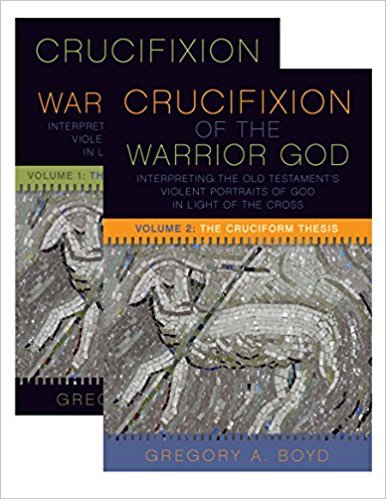We run our website the way we wished the whole internet worked: we provide high quality original content with no ads. We are funded solely by your direct support. Please consider supporting this project.

Reviewing the Reviews: Tom Belt (Part 1)
Tom Belt has written a four-part review of Crucifixion of the Warrior God on his blog An Open Orthodoxy. Parts 1 and 2 offer an overall fair and balanced summary of CWG, at least to the point that correcting misunderstandings would feel petty. In Part 3 Tom offers a critique of volume I, and this is what I’d like to respond to today. Then, sometime in the next day or two, I’ll post a response to Part 4 of Tom’s review in which he critiques volume II.
Tom praises a number of things about CWG, but he has seven criticisms of volume 1 that I find most interesting and would like to respond to.
1. Tom didn’t feel like CWG reflected my best writing.
Response: What can I say? I did my best. The only thing that makes this critique worth responding to is that this is the first time I’ve heard this criticism. In fact, over the last two months, since CWG was released, I have uniformly heard the exact opposite. Dozens of people have told me that even though CWG is a thoroughly academic book, they found it to be surprisingly readable and certainly more clearly written for non-specialists than my other academic works (e.g. God at War).
2. Tom notes that I provide no definition of violence, and he thinks this is a huge oversight.
Response: It’s true I provide no formal definition of violence, and while this may have been a mistake, it was not an oversight. In a lengthy footnote (ch.1, n.34), I explain why I provide no definition of violence while drawing three categories of actions that I believe shouldn’t be considered violent. I also refer readers to several works that debate this issue.
I chose to go this route because if anyone would deny that (say) the command for Israelites to exterminate Canaanites is a “violent” command, I doubt that they would be persuaded of an alternative definition simply because I provided one. At the same time, if I were to attempt a robust defense of my alternative definition and a robust refutation of all the definitions that disagree with mine, that would pretty much require a volume of its own and would take us far off track. I was thus okay with restricting my focus to people who agree that the portraits of God killing people and commanding others to do the same are violent – regardless of what precise definition of violence they adhere to.
3. Tom thinks it is disingenuous for me to appeal to my doctoral dissertation, Trinity and Process, in CWG, when (he claims) I now disagree this work.
Response: This is an exceedingly strange objection. It’s strange because it has nothing whatsoever to do with the thesis of CWG. It’s also strange in that the charge that I’m “disingenuous” (which he has publically repeated in other venues) feels ad hominem inasmuch as it calls into question my integrity. Why Tom felt the need to go there escapes me.
Tom doesn’t make explicit what he’s referring to, but I think he is referring to a footnote in which I refer readers to Trinity and Process if they care to read my metaphysical defense of the classical understanding that the Trinity exists prior to, and apart from, the God-world relationship (in opposition to process theology). And I think Tom is suggesting that it is disingenuous of me to refer to my argument in this dissertation because I espouse a kenotic Christology that he believes undermines a core aspect of the conclusion I arrive at in Trinity and Process.
For the sake of argument, let’s assume Tom is right about this How does referring interested readers to my over-all argument in Trinity and Process render me “disingenuous?” I happen to think I make a very good argument, even if I now disagree with one aspect of the conclusion I arrived at.
But as I’ve privately discussed with Tom several times, I am not convinced that my kenotic Christology undermines the view I defend in Trinity and Process. It certainly qualifies it, but I am actually quite confident my dissertation could accommodate a kenotic Christology. If I had enough interest in this topic, I would flesh this all out and blog on it. As it stands, however, I don’t.
Tom is of course free to think I’m off my rocker in thinking I can reconcile my dissertation with a kenotic Christology, but surely this is insufficient grounds for calling my integrity into question simply because I refer back to my dissertation.
4. Tom says “Greg suggests that the Cross exclusively, understood independently of all passages outside the passion narratives, is a better hermeneutical center than the entirety of Christ’s life (teachings, death, resurrection).”
Response. This is blatantly incorrect. In a section entitled “The Unity of the Person and Work of Jesus Christ” (vol. 1, pp.161-71) and then throughout chapter 5, entitled “The Cross as the Thematic Center of the Gospel,” I make the case and repeatedly emphasize that the cross should not be understood “exclusively,” independent of “passages outside the passion narratives.” Hence, it should never be consider a “hermeneutical center” over-and-against “the entirity of Christ’s life (teachings, death, resurrection).” This is precisely the mistake the Reformers tended to make, and it skewed their understanding of the cross in fundamental ways.
I rather argue that the cross should be seen as the through-line, the thematic-center, the summation and culmination everything Jesus was about from his Incarnation to his Ascension. How Tom got this so fundamentally wrong is not clear to me.
5. Tom pointed out that the cross has been, and continues to be, interpreted in a variety of ways. “[T]he Cross that constitutes the hermeneutical center for Greg is a very specific Cross. It’s not a Calvinist Cross, an Orthodox Cross, or a Fundamentalist Cross.”
Response: Tom is obviously right that the cross has been understood in different ways. But who ever said otherwise? Rather than pointing out the obvious, I would have thought it would have been more interesting if Tom had evaluated the lengthy case I make for my particular understanding of the cross as well as my particular critiques of other understandings.
6. Tom wonders why I’m bound to Christ’s view of Scripture. “Greg seems to take it for granted that Christ’s view of Scripture ought to define his own simply because it’s the opinion of the Son of God. But Greg holds that Christ held false beliefs (generally) and about biblical characters (in particular), Adam and Eve being the historical couple who started the human race, for example. But Greg doesn’t feel it necessary to agree with Christ on these other issues. Why is Christ’s view of Scripture any different? Greg doesn’t say.”
Response: Tom is right that my faith in the “God-breathed” nature of Scripture is anchored in my conviction that Christ endorsed the biblical narrative as “God-breathed.” If I confess Jesus as Lord, I don’t feel free to correct his theology. Sure, as a first century person, Jesus undoubtedly believed a number of things that we now know are inaccurate, such as the ancient belief that we see by light going out from our eyes (Mt 6:22-23). But as I note in CWG, in contrast to these incidental mistaken beliefs, Jesus’ view of Scripture is central to his identity, mission and world view. I thus consider agreeing with his view of Scripture is as mandated by professing him Lord as is obeying his kingdom ethics (Lk 6:46),
But Tom is misguided when he thinks I disagree with Jesus’ view of Adam and Eve, or any other biblical characters or events Jesus alludes to. As I argue in chapter 8, because I believe the biblical narrative is “God-breathed,” I feel compelled to treat all characters and events within this narrative as factual – the way Jesus did- when I’m reading the Bible as the inspired word of God, and therefore in a pre-critical manner – again, the way Jesus did.
What Tom must be referring to when he claims I feel free to disagree with Jesus is my conviction that affirming the “God-breathed” facticity of biblical characters and events within the biblical narrative does not require us to insist that these characters and events correspond to “actual history” (which, of course, refers to any particular historical-critical reconstruction of what happened in the past). In my opinion, in other words, the “God-breathed” nature of the biblical narrative is independent of a historical-critical assessment of the historical veracity of the biblical narrative. This is why I disagree with advocates of the “Dismissal Solution” that we’ve solved the challenge posed by violent portraits of God when we’ve made a case that the narratives they are contained in are not historically accurate.
In any event, by granting that the story of Adam and Eve (or any other particular biblical characters or events) may not correspond to “actual history,” I am not disagreeing with Jesus. For as is true of everybody up until the Enlightenment period, Jesus read the biblical narrative in a pre-critical way, with a view to what it revealed about God and the human situation. He was not reading the biblical narrative in a historical-critical way in order to assess the degree to which particular biblical characters and events correspond or fail to correspond to a particular scholarly reconstruction of what actually happened.
It is within this pre-critical framework that Jesus accepted the facticity of all biblical events and characters. And this is the perspective I believe Christians should, at the very least, carefully consider.
7. Finally, Tom argues: “The Hebrew canon was not closed and thus could not have provided an objective standard to which Jesus’ opinion could refer. The question of whether and if so how Jesus’ opinion of the nature of the Hebrew Scriptures (if we can even know exactly which books Jesus took to be “scripture”) ought to obligate Christian opinion on the same issues is more interesting and thorny a problem than Greg recognizes in the opening comments of vol. 1 that describe his “conundrum.” … Greg didn’t stop to consider the complexities.”
Response: As ch.8, footnote 43 makes clear, I am fully aware of the “thorny problem” and “complexities” surrounding the issue of what particular books comprised the canon at the time of Jesus. Did Tom overlook this? I relegate this issue to a footnote and simply refer to relevant scholarly discussions because nothing hangs in the balance on how, if at all, we resolve this “thorny” and “complex” issue. It is enough for me to note that Jesus considered the biblical books, character and events that he alludes to be factual (in the pre-critical sense of the word), for they were contained in the biblical narrative that was “God-breathed.” What other books Jesus may or may not have thought should be in or out of the canon is an interesting question, but one that is completely irrelevant for the purposes of this book.
Enough for today. Stay tuned for a look at Part 4 of Tom’s review, in which he critiques volume II of CWG. As you’ll see, here is where Tom’s review really starts to heat up!
Category: General
Tags: Crucifixion of the Warrior God, Cruciform Theology, Reviews, Tom Belt
Topics: Interpreting Violent Pictures and Troubling Behaviors
Related Reading

A Dialogue with Derek Flood: Is the Bible Infallible?
I’m happy to see that Derek Flood has responded to my four part review of his book, Disarming Scripture. His response—and, I trust, this reply to his response—models how kingdom people can strongly disagree on issues without becoming acrimonious. And I am in full agreement with Derek that our shared conviction regarding the centrality of…

How NOT to be Christ-Centered: A Review of God With Us – Part II
In Part I of my review of Scott Oliphint’s God With Us we saw that Oliphint is attempting to reframe divine accommodation in a Christ-centerd way. Yet, while he affirms that “Christ is the quintessential revelation of God,” he went on to espouse a classical view of God that was anchored in God’s “aseity,” not…

Who is Responsible for Job’s Suffering?
In the prologue of the Book of Job, the author seems to ascribe the responsibility for Job’s affliction to Yahweh. For instance, Satan challenges God to “stretch out [his] hand and strike everything he has,“ believing that this would incite Job to curse God to his face (1:11). The fact that the Lord responds by…

When God Abandoned God
On the cross, Jesus’ cried out, “Eli, Eli, lema sabachthani?” – which means, “My God, my God, why have you forsaken me? (Mt. 27:46). These are arguably the most shocking, beautiful, and profoundly revelatory words found in Scripture. The cry reveals that on Calvary, the all-holy Son of God experienced God-forsakenness as he bore the…

Atonement: What is the Christus Victor View?
Most western Christians today understand the atonement as a sort of legal-transaction that took place between the Father and the Son that got humanity “off the hook.” The legal-transaction scenario goes something like this: God’s holiness demands that all sin be punished, which in turn requires that sinners go to eternal hell. The trouble is,…

Podcast: Does God Strike Jesus Down?
Greg looks at how Matthew uses the Old Testament—specifically, Matthew 26:31. http://traffic.libsyn.com/askgregboyd/Episode_0258.mp3
